A two-pronged detection of atherosclerosis with a dual-channel fluorescent probe for viscosity and hypochlorous acid
Zhenkai Wang【王振凯】,‡ Shan Wang,‡ Bingya Wang, Jianliang Shen,a Linlu Zhao【赵琳璐】,* Fabiao Yu【于法标】,* Ji-Ting Hou【后际挺】*
a National Engineering Research Center of Ophthalmology and Optometry, Eye Hospital, Wenzhou Medical University, Wenzhou 325027, China
b Key Laboratory of Hainan Trauma and Disaster Rescue, The First Affiliated Hospital of Hainan Medical University, Hainan Medical University, Haikou 571199, China
c Key Laboratory of Intelligent Treatment and Life Support for Critical Diseases of Zhejiang Province, the First Affiliated Hospital of Wenzhou Medical University, Wenzhou 325000, China
d Key Laboratory of Clinical Laboratory Diagnosis and Translational Research of Zhejiang Province, The First Affiliated Hospital of Wenzhou Medical University, Wenzhou 325000, China
e Engineering Research Center for Hainan Bio-Smart Materials and Bio-Medical Devices, Key Laboratory of Emergency and Trauma, Ministry of Education, Key Laboratory of Hainan Functional Materials and Molecular Imaging, College of Emergency and Trauma, Hainan Medical University, Haikou 571199, China
Chemical Engineering Journal 464 (2023) 142687
https://doi.org/10.1016/j.cej.2023.142687
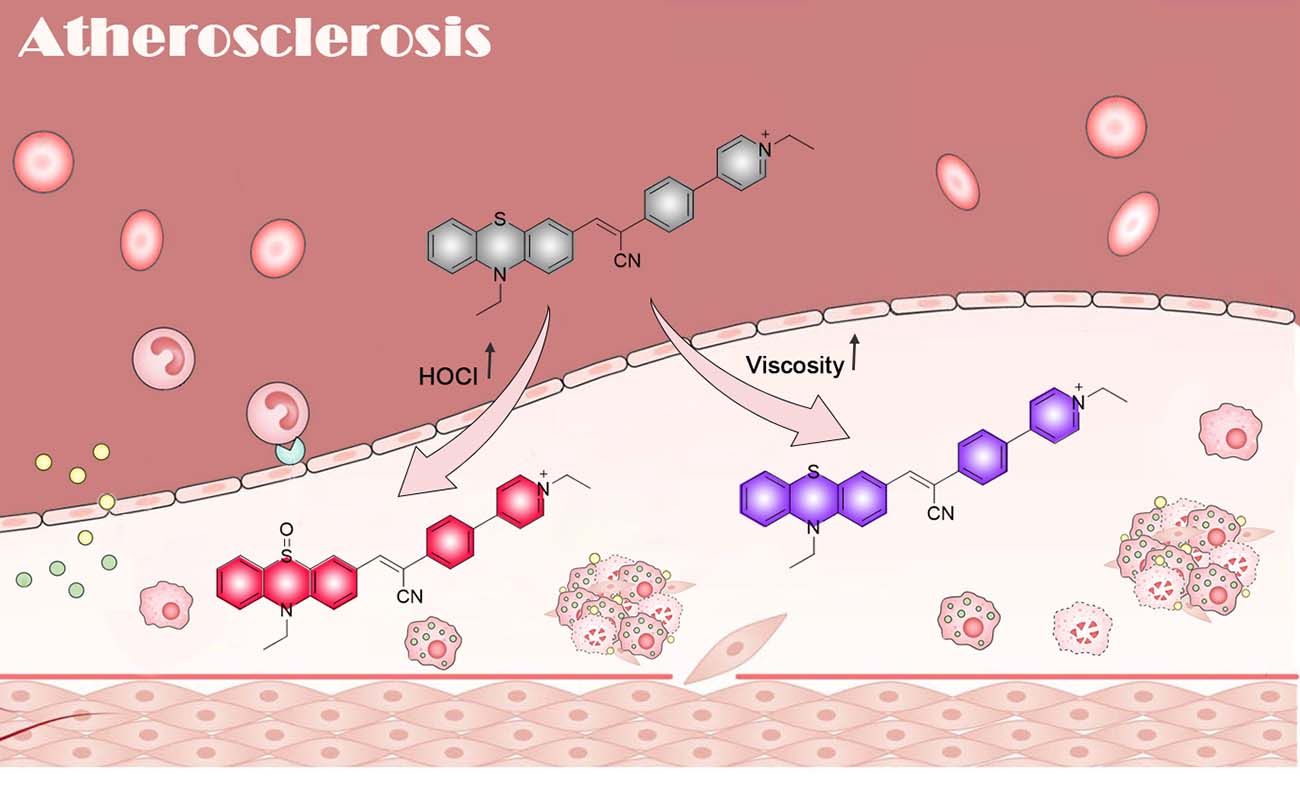
A B S T R A C T
The precise detection of atherosclerosis has been a reserch hot point since its importance in the diagnosis of cardiovascular diseases. Here we synthesized a near-infrared fluorescent probe AS-CN with a D π A structure, enabling independent dual-response determination of hypochlorous acid (HOCl) and viscosity during AS progression. The performance of this probe is excellent, with large Stokes shift, low detection limit, high sensitivity, and good biocompatibility. The simultaneous variations of HOCl and viscosity during the formation of foam cells were successfully investigated for the first time. Especially, we further applied it to achieve the non-invasive in vivo detection in the atherosclerotic mouse and realized the evaluation of atherosclerosis from chemical (ROS) and physical (viscosity) dimensions, respectively. We hope that AS-CN acts as a potent tool in the detection of atherosclerosis.
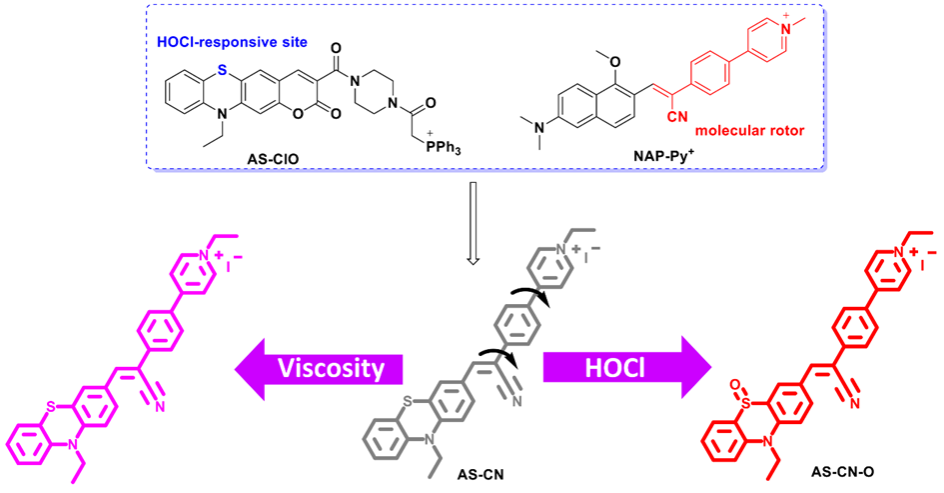
Scheme 1. Design strategy of AS-CN and its schematic response mechanism to HOCl and viscosity.
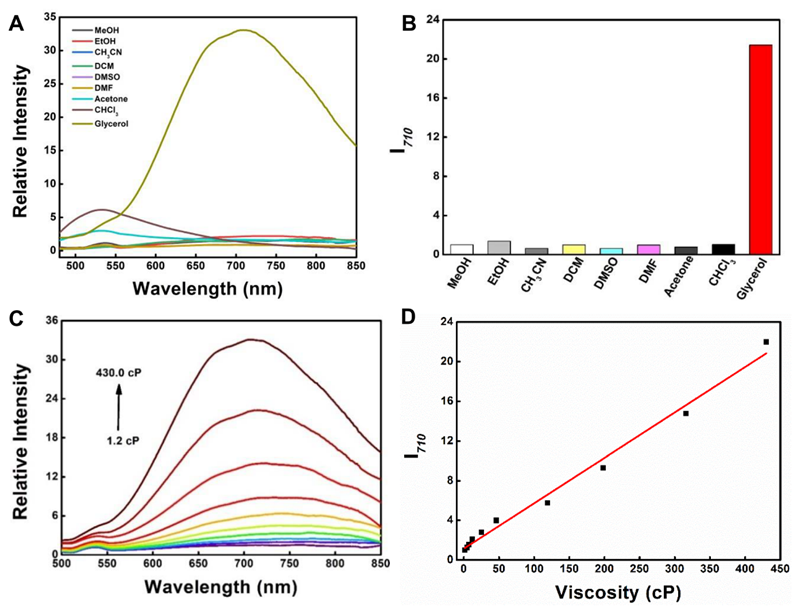
Figure 1. Optical response of AS-CN to viscosity. (A) Fluorescence spectra of AS-CN (10 μM) in different organic solvents. (B) Fluorescence intensity of AS-CN at 710 nm in different organic solvents. (C) Fluorescence spectra of AS-CN in MeOH with increasing fractions of glycerol. (D) Linear response between fluorescence intensity I710 and viscosity. λex = 460 nm. λem = 710 nm, slit width: 5 nm/5 nm.

Figure 2. Optical response of AS-CN to HOCl. (A) Fluorescence spectrum of AS-CN (10 μM) before and after addition of various reactive species. (PBS, pH 7.2-7.4, 10 mM). (B) The intensity changes of AS-CN before and after addition of various reactive species, and the color of the solution after adding different reactive oxygen species and AS-CN. (C) UV-vis spectrum of AS-CN (10 μM) toward various concentrations of ClO– in 20% EtOH solution. (PBS, pH 7.2-7.4, 10 mM). (D) Fluorescence spectrum of AS-CN (10 μM) toward various concentrations of ClO– in 20% EtOH solution. (PBS, pH 7.2-7.4, 10 mM). (E) Linear relationship between the fluorescence intensity log(I593) of AS-CN (10 μM) and the concentrations of ClO– (1-10 μM). (F) Time-dependent kinetic measurement of the fluorescent response to ClO– (50 μM) of AS-CN (10 μM). λex = 395 nm, λem = 593 nm, slit width: 3 nm/3 nm.
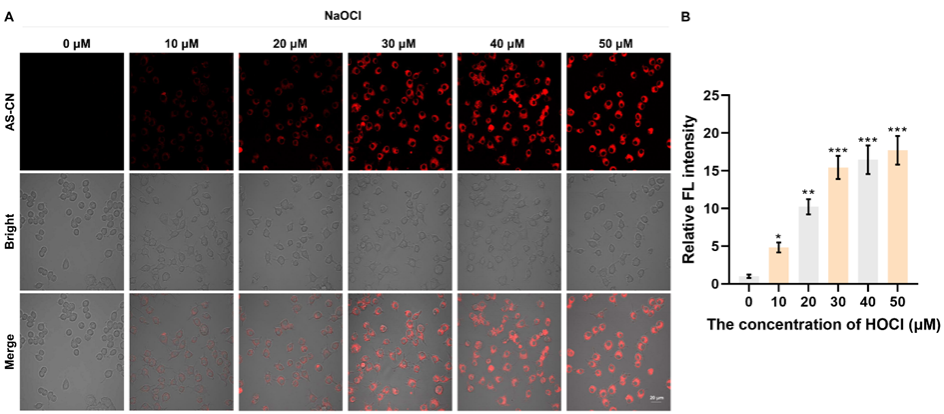
Figure 3. Response of AS-CN to exogenous HOCl in RAW264.7 cells. (A) RAW264.7 cells were treated with 0-50 μm NaOCl for 30min, then treated with AS-CN (10 μM) for 30min, and imaged under a laser confocal microscope. λex=405 nm, λem=500-600 nm. Scale bar: 20 μm. (B) Normalized average fluorescence intensity of AS-CN. Data are mean ± SEM. * p<0.05, ** p<0.01, *** p<0.001. Analyzed cells were obtained from three replicates.
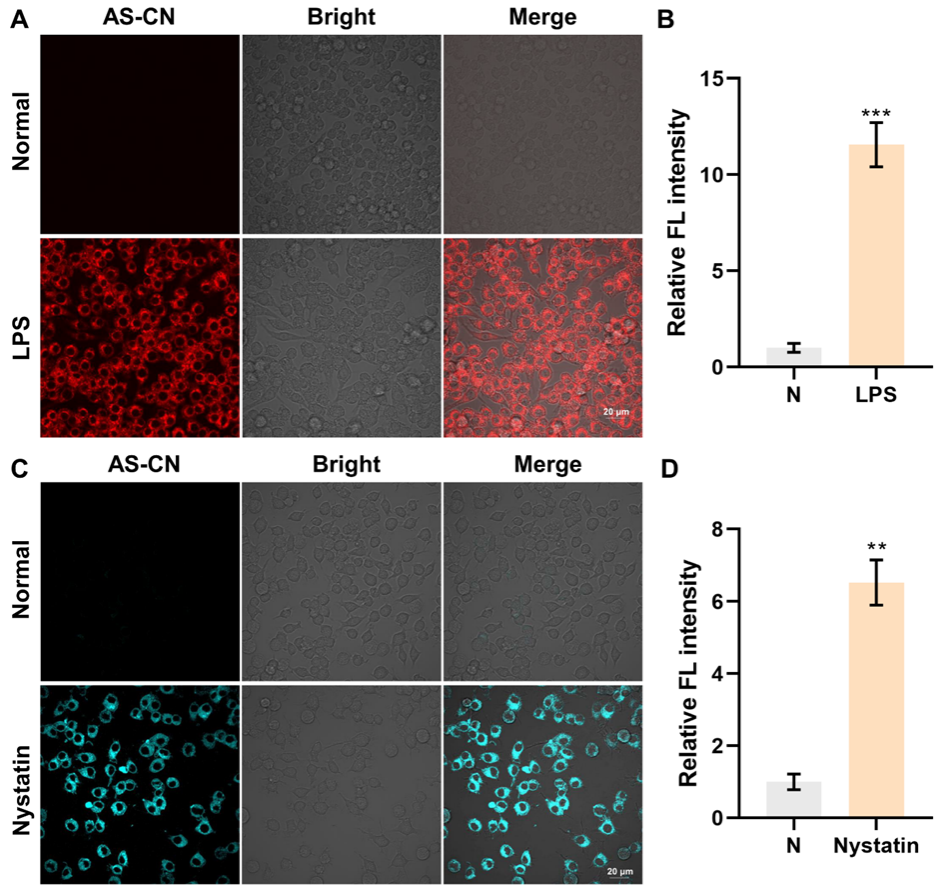
Figure 4. Response of AS-CN to endogenous HOCl and viscosity in RAW264.7 cells, respectively. (A) RAW264.7 cells were treated with LPS (1 μg/ml) for 6 h, then treated with AS-CN (10 μM) for 30 min, and imaged under a confocal laser. λex=405 nm, λem=500-600 nm. (B) Normalized average fluorescence intensity in A. (C) RAW264.7 cells were first treated with nystatin (10 μM) for 6 h, then AS-CN (10 μM) for 30 min, and imaged by confocal laser. λex=445 nm, λem=690-790 nm. (D) Normalized average fluorescence intensity in C. Data are mean ± SEM. *** p<0.001. Analyzed cells were obtained from three replicates. Scale bar: 20 μm.
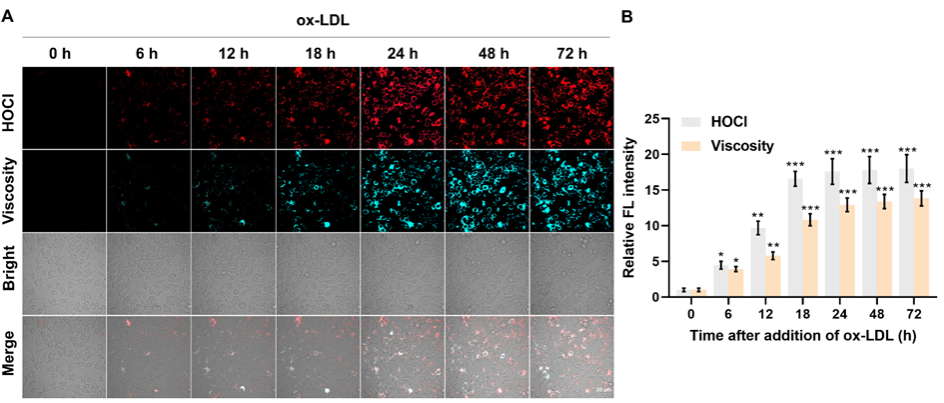
Figure 5. Fluorescence imaging of changes in HOCl and viscosity levels during foam cell formation by AS-CN. (A) The first row: the red fluorescence channel image of HOCl imaging; the second row: the blue fluorescence channel image of viscosity imaging; the third row: cell brightfield image; the fourth row: the three overlay images. (B) Normalized average fluorescence intensity of AS-CN. Data are mean ± SEM. * p<0.05, ** p<0.01, *** p<0.001. Analyzed cells were obtained from three replicates. Red channel: λex = 405 nm, λem =500−600 nm; Blue channel: λex = 445 nm, λem =690−790 nm. Scale bar: 20 μM.
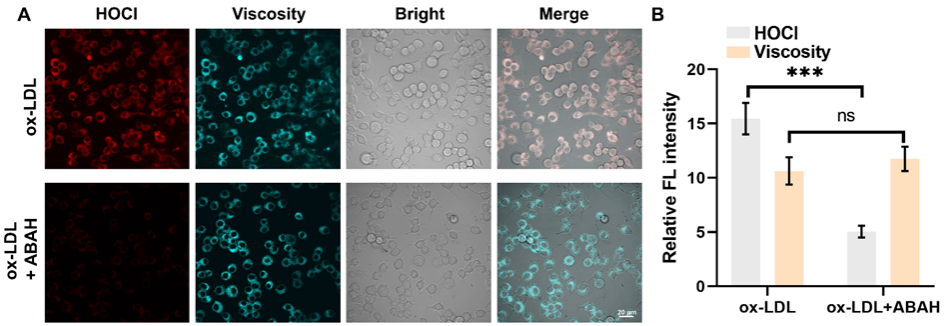
Figure 6. Verification experiment of dual-channel response of AS-CN. (A) The first row: RAW264.7 cells were pretreated with ox-LDL (20 μg/mL) for 18h, and then treated with AS-CN (10 μM) for 30 min; The second row: RAW264.7 cells were pretreated with ABAH (100 μM) for 3 h, then treated with ox-LDL (20 μg/mL) for 18 h, and treated with AS-CN (10 μM) for 30 min; (B) Normalized average fluorescence intensity of AS-CN. Data are mean ± SEM. *** p<0.001, ns: no statistical significance. Analyzed cells were obtained from three replicates. Red channel: λex = 405 nm, λem =500−600 nm; Blue channel: λex = 445 nm, λem =690−790 nm. Scale bar: 20 μM.
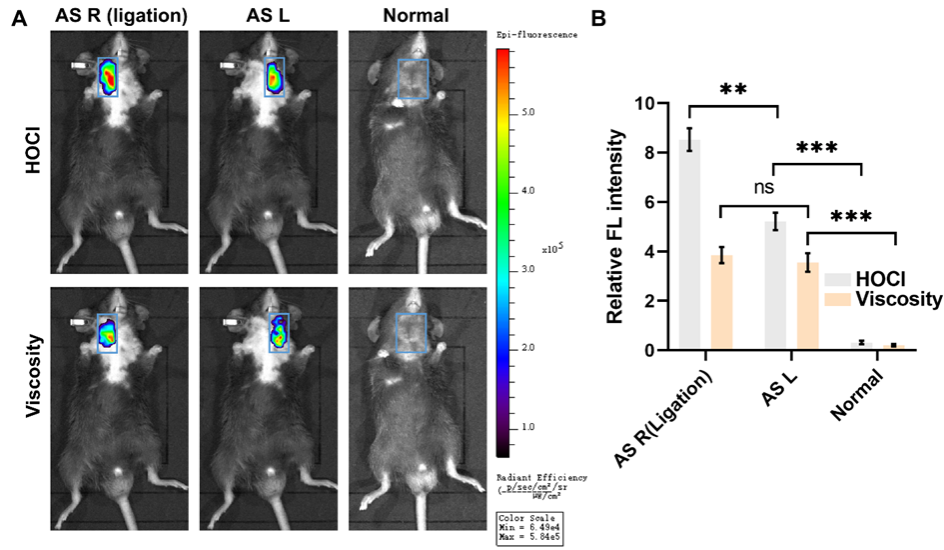
Figure 7. Application of AS-CN in mice. (A) Noninvasive small animal in vivo fluorescence imaging of the left and right carotid arteries of the ligated AS mice and the carotid arteries of the healthy control group. (B) Average fluorescence intensity of AS-CN in figure A. Data are mean ± SEM. ** p<0.01, *** p<0.001, ns: no statistical significance. Analyzed cells were obtained from three replicates. HOCl channel: λex = 430 nm, λem =500−600 nm; Viscosity channel: λex = 430 nm, λem =690−790 nm.
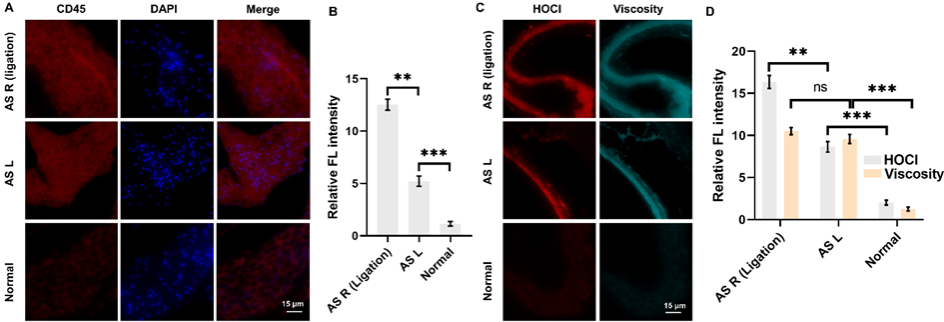
Figure 8. (A) CD45 immunofluorescence staining of carotid artery sections and (B) the normalized average fluorescence intensity of CD45. (C) Fluorescent imaging of the HOCl (red) and viscosity (cyan) channels of AS-CN and (D) the normalized average fluorescence intensity of AS-CN. Data are mean ± SEM, P < 0.05 is considered significant. ** p<0.01, *** p<0.001, ns no statistical significance. Analyzed cells were obtained from three replicates. CD45 channel: λex = 561nm, λem =570-650nm; DAPI channel: λex = 364nm, λem =400-500nm HOCl channel: λex=405 nm, λem=500-600 nm; Viscosity channel: λex=445 nm, λem=690-790 nm. Scale bars on zoom images are 15 μm.
Cardiovascular disease remains the leading cause of death worldwide, and the occurrence and progression of atherosclerotic disease is often difficult to monitor, creating an urgent need for improved diagnostic techniques to detect early, asymptomatic, high-risk cardiovascular disease. Here, we propose a non-invasive detection approach using a dual-channel fluorescent probe AS-CN, to identify the degree of AS in vivo by detecting viscosity in a physical dimension and HOCl expression in a chemical dimension, respectively. Its fluorescence emission wavelength in response to viscosity is at 710 nm, and the fluorescence gradually increases with the increase of viscosity; the enhanced fluorescence response wavelength of HOCl is at 593 nm and has a superb sensitivity with the detection limit to be 12 nM. AS-CN not only has excellent performance in ordinary cell experiments, but also showcases feasibility for dynamically monitoring foam cell formation in two channels, which is extremely important for understanding underlying mechanism of atherosclerotic diseases at cellular level.
Finally, to further advance the clinicalization of this work, we applied AS-CN to non-invasive in vivo imaging in mice, and the results were encouraging. It is found that the HOCl changes can tightly reflect the degree of inflammation while viscosity changes reflect structural obstruction. Especially, lipid accumulation and inflammation progression are found to develop asynchronously. Thus, AS progression from different dimensions, i.e. chemical and physical, can be evaluated using HOCl and viscosity as biomarkers using a single probe.

